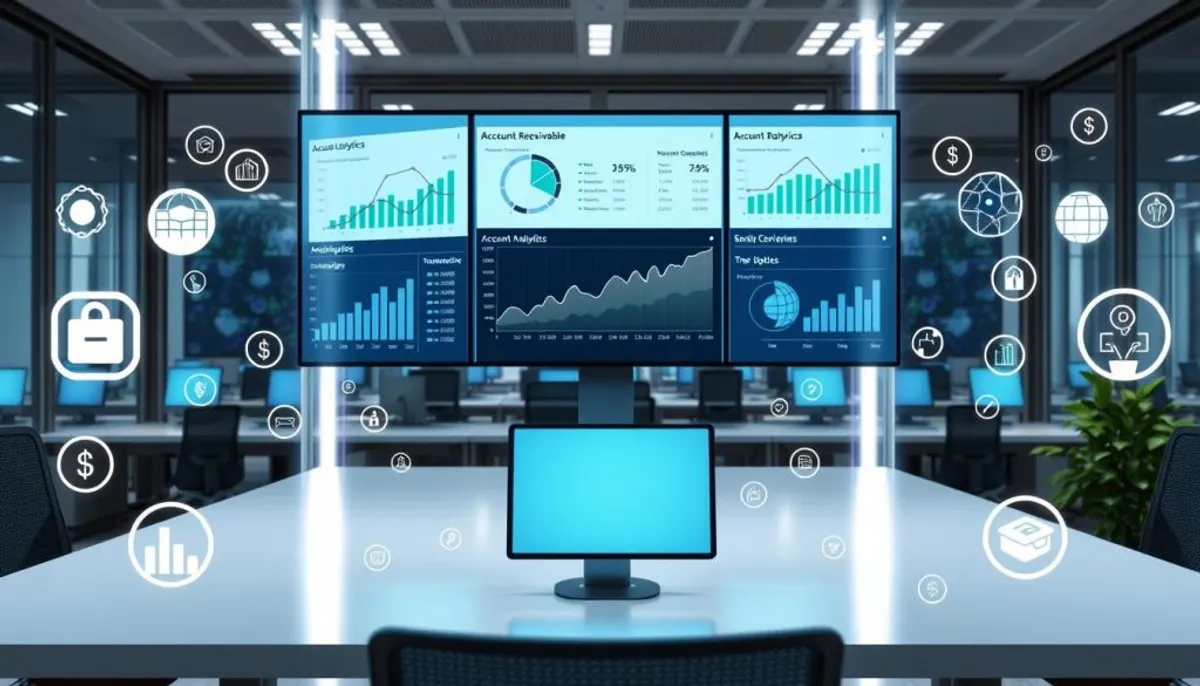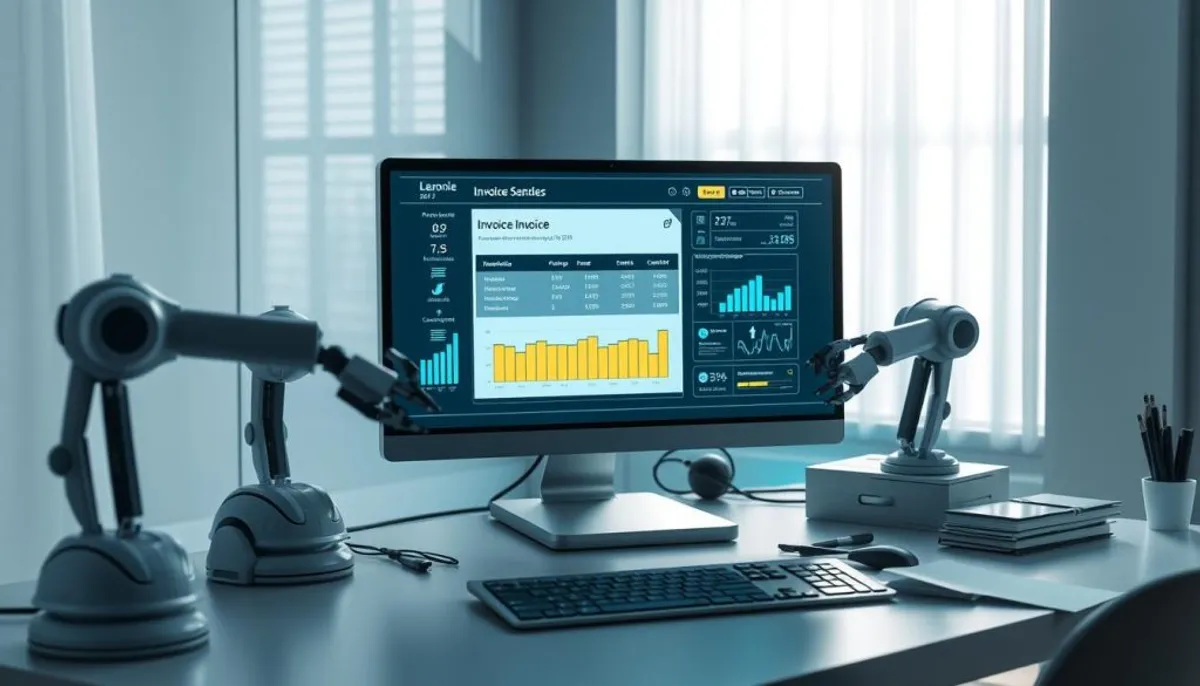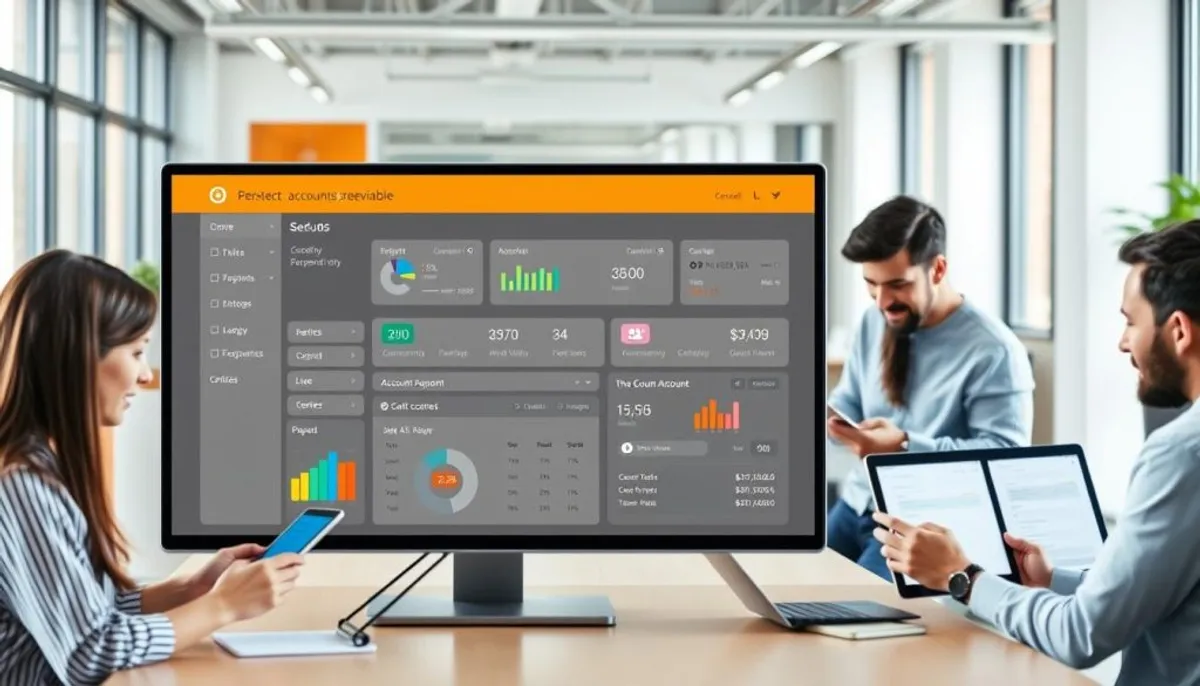In today’s fast-paced business world, accounts receivable automation software is revolutionizing how companies manage their finances. This powerful tool streamlines invoice processing, accelerates cash flow, and boosts operational efficiency. With 96% of C-level executives acknowledging the need for AR digitization, it’s clear that this technology is a game-changer.
AR automation software tackles outdated processes, enhances collaboration, and optimizes resource allocation. By implementing this innovative solution, businesses can overcome common challenges and achieve remarkable results. Let’s explore how this technology is transforming the financial landscape.

The impact of AR automation is substantial. It can lead to cost savings exceeding 70% in invoicing expenses and eliminate 100% of lockbox data capture fees. This technology frees up AR analysts from time-consuming tasks, allowing them to focus on strategic initiatives. With AI-powered features, businesses can predict payment dates and segment customers for more effective collection strategies.
Key Takeaways
- AR automation software streamlines invoice processing and accelerates cash flow
- Cost savings can exceed 70% in invoicing expenses
- AI capabilities enhance payment prediction and customer segmentation
- Self-service portals improve customer experience and payment speed
- Real-time data flow connects teams across the order-to-cash process
- 96% of C-level executives recognize the need for AR digitization
Understanding Modern AR Management Challenges
Today’s businesses encounter substantial obstacles in managing accounts receivable (AR) processes. The evolving AR management landscape introduces novel challenges, necessitating cutting-edge solutions.
Manual Process Pain Points
Traditional AR processes heavily rely on manual effort, resulting in numerous issues. Slow payment times, billing errors, and time-consuming tasks burden many organizations. Companies employing outdated methods often face misbilling, underbilling, or overbilling, significantly impacting their profitability.
Impact on Business Cash Flow
Inefficient AR processes directly impair a company’s financial health. Delayed payments and inaccurate billing disrupt cash flow, hindering business operations. Many CFOs lack real-time access to financial data, making it challenging to identify weaknesses and make informed decisions. This outdated approach to cash flow management can leave businesses vulnerable to financial instability.
Current Market Challenges
The AR landscape is rapidly evolving, placing pressure on businesses to adapt. External forces create major headaches for 99% of executives, increasing the need for robust accounts receivable management tools. Outdated processes, insufficient resources, and inconsistent policies further complicate AR management. To stay competitive, businesses must embrace AR workflow automation to streamline operations, improve accuracy, and enhance customer relationships.
| Challenge | Impact | Solution |
|---|---|---|
| Manual Processes | Errors, delays, wasted time | AR automation software |
| Cash Flow Issues | Financial instability | Real-time data access |
| Customer Relationships | Dissatisfaction, disputes | Efficient collection methods |
What is Accounts Receivable Automation Software
Accounts receivable automation software transforms the financial management landscape for businesses. It automates tasks like invoice creation, payment handling, and reconciliation. This digital approach minimizes manual effort, enhancing efficiency in accounts receivable functions.
Receivables automation platforms leverage cutting-edge technologies, including AI and robotic process automation. These tools automate tasks from data entry to sending late payment alerts. This leads to quicker processing, fewer errors, and better cash flow management.
- Reduced processing time
- Improved efficiency
- Enhanced security
- Decreased human errors
- Better customer experiences
Businesses adopting automated billing systems witness substantial enhancements. Here are some statistics:
| Metric | Impact |
|---|---|
| Overall process speed improvement | 87% of businesses |
| Enhanced customer experience | 75% of businesses |
| Average payment receipt time (high automation) | 55 days |
| Average payment receipt time (low automation) | 78 days |
Implementing receivables automation platforms allows businesses to concentrate on strategic activities and analysis. This drives growth and enhances financial health.
Core Features and Capabilities
Accounts receivable automation software introduces a suite of advanced features to enhance financial operations. These innovations transform the management of invoicing, payment processing, and collections for businesses.
Invoice Generation and Processing
The advent of automated invoice processing marks a significant shift in financial management. Intelligent invoice capture empowers companies to dispatch invoices swiftly and with precision. This advancement minimizes errors and accelerates the billing cycle.

Payment Processing and Reconciliation
Contemporary AR software integrates with multiple payment gateways, facilitating electronic transactions. This integration expedites payment processing and simplifies reconciliation. The collection of real-time data enables accurate cash forecasting, guiding businesses in making strategic financial decisions.
Collections Management Tools
Effective collections management is vital for sustaining a healthy cash flow. AR automation software employs personalized payment reminders and tracks interactions with customers. It also offers insights into AR aging, fostering a proactive approach to reduce late payments and enhance collections efficiency.
Integration Capabilities
Seamless integration with existing accounting or ERP systems is a hallmark of AR automation software. This integration ensures data coherence across platforms, obviating the need for manual data entry. The range of integration capabilities varies among providers, necessitating a selection that meets specific business requirements.
| Software | Basic Plan | Advanced Plan |
|---|---|---|
| Envoice | $7/month | $14/month |
| QuickBooks Online | $35/month | $235/month |
| FreshBooks | $19/month | $60/month |
Financial Benefits of AR Automation
AR automation offers significant financial advantages to businesses. By implementing accounts receivable workflow automation, companies can achieve substantial cost savings and efficiency improvements. Let’s examine the primary financial benefits of AR automation.
Cost Reduction Analysis
AR automation significantly reduces operational expenses. It streamlines invoice processing, saving businesses up to 35,000 administrative hours annually. This time savings leads to lower labor costs and enhanced productivity. Electronic invoicing through AR automation also saves teams between 41 and 60 hours weekly, typically spent on unpaid invoices.
ROI Measurements
The AR automation ROI is highly attractive. Businesses using automated AR software can save $4.9 million annually in consumer bad debt. This substantial reduction in bad debt alone justifies the investment in AR automation solutions. The time saved through automation also allows staff to focus on more valuable tasks, further increasing ROI.
Cash Flow Optimization
AR automation greatly enhances cash flow management. It offers multiple payment options like credit cards, digital wallets, and bank transfers, improving customer convenience and potentially boosting conversion rates. Automation in credit management also helps identify negative payment trends, reducing bad debts and ensuring healthier cash flow.
| Metric | Impact of AR Automation |
|---|---|
| Administrative Hours Saved | Up to 35,000 per year |
| Invoice Processing Time Saved | 41-60 hours per week |
| Annual Savings in Bad Debt | $4.9 million |
| C-level Executives Recognizing CX Importance in AR | 97% |
Operational Efficiency Improvements
AR process optimization through automation software significantly enhances operational efficiency. It streamlines the order-to-cash process, freeing AR analysts from tedious manual tasks. This enables teams to concentrate on strategic work, driving growth and innovation.
One of the primary advantages of accounts receivable efficiency is the decrease in data entry errors. Automated systems reduce these mistakes, leading to more accurate receivables data management. This accuracy results in fewer payment delays and disputes, improving overall cash flow management.
Real-time visibility into invoice statuses and receivables is another critical benefit. AR automation allows for seamless payment tracking, offering instant financial health insights. This transparency empowers decision-makers to make swift, informed choices.
- Reduced manual workload
- Improved data accuracy
- Real-time payment tracking
- Streamlined end-to-end processes
Implementing AR automation leads to substantial cost savings and productivity increases. The software integrates all AR process teams, facilitating a smooth flow of real-time data. This integration fosters better collaboration and more efficient problem-solving.
As AR process optimization advances, artificial intelligence and machine learning become more pivotal. These technologies offer valuable payment trend insights and optimize collection strategies. This further enhances accounts receivable efficiency.
Enhanced Customer Experience Benefits
AR automation transforms customer interactions, simplifying the payment process. Through self-service AR portals, businesses can deliver a seamless AR customer experience. This aligns with today’s high expectations.
Self-Service Payment Options
Self-service AR portals grant customers the power to manage their accounts autonomously. They can access invoices, make payments, and monitor transaction history at their leisure. This autonomy boosts customer satisfaction and accelerates the payment cycle.

Communication Improvements
AR automation enhances communication between businesses and customers. It facilitates automated reminders, personalized notifications, and real-time updates. These keep customers abreast of their account status. This proactive communication reduces misunderstandings and fosters trust.
Dispute Resolution Process
Efficient dispute resolution is vital for maintaining positive customer relationships. AR automation streamlines this process by:
- Providing a centralized platform for raising and tracking disputes
- Automating the routing of disputes to appropriate team members
- Offering insights into common dispute causes for process improvement
By integrating AR automation, businesses can significantly elevate their AR customer experience. Self-service AR portals, enhanced communication, and streamlined dispute resolution contribute to increased customer satisfaction and loyalty.
Implementation of ti3 Platform
Introducing ti3 AR automation into your workflow dramatically streamlines accounts receivable processes. It slashes invoice processing time by an impressive 80%. This cutting-edge platform boasts a user-friendly setup, effortless integration with your existing systems, and comprehensive training. This ensures a smooth transition and maximizes user adoption.
Setup Process Overview
The ti3 platform’s setup is designed to be both straightforward and efficient. It commences with a detailed analysis of your current AR processes. This assessment is pivotal in customizing the ti3 AR automation to align perfectly with your business’s unique requirements.
Integration with Existing Systems
ti3 integrates seamlessly with your current financial systems. This integration facilitates automated data transfer, significantly reducing manual entry errors by 66%. The implementation process is crafted to cause minimal disruption to your ongoing operations.
User Training and Adoption
Ensuring effective user training is essential for successful ti3 AR automation adoption. The platform provides extensive training programs. These are designed to empower your team to fully utilize its capabilities. This focus on user adoption can lead to substantial time savings, up to 50 hours weekly on invoice preparation.
| Implementation Aspect | Benefit |
|---|---|
| Setup Process | 80% reduction in invoice processing time |
| System Integration | 66% reduction in data entry errors |
| User Training | 50 hours saved weekly on invoice preparation |
By embracing ti3 AR automation, businesses can profoundly enhance their accounts receivable processes. This leads to superior cash flow management and a notable reduction in operational costs.
Data Analytics and Reporting Capabilities
AR analytics and accounts receivable reporting have become indispensable for contemporary enterprises. These functionalities enable finance teams to base their decisions on data, thus refining their receivables management tactics.
AR automation software compiles detailed reports on pivotal metrics such as accounts receivable aging, cash flow projections, and collection efficacy. These insights enable businesses to monitor their financial status and pinpoint opportunities for enhancement.
The essence of AR analytics resides in its capacity to offer immediate data insights. CFOs now benefit from expedited closing periods, enhanced auditability, and diminished risk exposure. This immediate access to data facilitates more precise decision-making throughout the organization.
| Key AR Metrics | Description | Impact |
|---|---|---|
| Days Sales Outstanding (DSO) | Tracks average time to collect payments | 80% of companies see late payments as a threat |
| Collection Effectiveness Index (CEI) | Evaluates order-to-cash team performance | Guides decisions on collection policies |
| Accounts Receivable Turnover Ratio (ART) | Indicates payment collection speed | Helps manage cash flow effectively |
| Bad Debts | Tracks uncollectible accounts | 26% increase in recent years |
Advanced AR analytics transcend basic reporting. They introduce predictive functionalities, enabling businesses to forecast bad debts with precision and devise strategies to mitigate them. This forward-thinking approach to financial management can substantially bolster a company’s profitability.
AR automation software, with its seamless integration capabilities, facilitates effortless data export to corporate reporting systems. This facilitates thorough financial analysis and ensures that all departments have access to critical AR data.
Conclusion
AR automation is revolutionizing the financial sector for enterprises across the spectrum. The integration of accounts receivable software yields substantial returns on investment. Businesses witness notable enhancements in operational efficiency and productivity. Research indicates that AR automation enables companies to dedicate 62% of their time to customer payment interactions, thus strengthening relationships and diminishing late payment occurrences.
The effects on cash flow are profound. Automated invoicing and payment reminders expedite the collection cycle, significantly bolstering working capital management. This efficiency is mirrored in critical metrics such as Days Sales Outstanding (DSO) and Accounts Receivable Turnover Ratio (ART), both pivotal for assessing financial health.
AR automation’s benefits extend beyond financial gains to operational excellence. The diminishment of manual data entry errors and the streamlining of reconciliation processes lead to more precise financial records. This accuracy, combined with real-time insights, empowers businesses to make strategic decisions and adapt swiftly to market shifts.
In today’s fiercely competitive business arena, the adoption of accounts receivable software is imperative, not optional. By embracing these technologies, companies can refine their financial operations, elevate customer satisfaction, and secure sustainable growth in a rapidly evolving marketplace.
RelatedRelated articles



